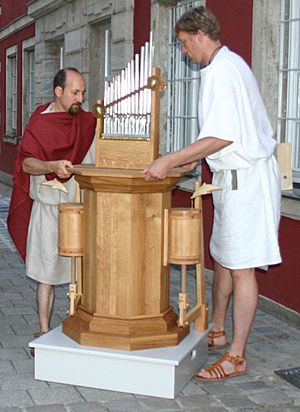Water organ facts for kids
The water organ is a special kind of pipe organ. It makes sound when air blows through its pipes, just like a modern organ. But instead of using big air pumps called bellows or electricity, the water organ uses the power of flowing water, like from a waterfall!
This amazing instrument, also known as a hydraulis, was invented a very long time ago, around 300 BC. A clever scientist named Ctesibius of Alexandria probably created it. It was actually the world's first keyboard instrument! Over many centuries, it slowly changed and became the modern pipe organ we know today.
How the Water Organ Works
The water organ works in a very clever way. Water and air both enter a special chamber called the camera aeolis (which means "wind chamber"). Inside this chamber, the water and air separate. The air gets squeezed and then pushed into a pipe called a "wind-trunk." This compressed air then blows into the organ pipes, making music!
To stop water from splashing into the organ pipes, there are two special "splash plates" inside. After the water separates from the air, it flows out of the camera aeolis at the same speed it came in. This flowing water then turns a water wheel. This water wheel helps to move a musical cylinder, which controls what notes the organ plays. To start the music, you just turn on a tap that lets water flow into the organ. As long as the water keeps flowing, the organ will play until you turn the tap off!
Water Organs in History
During a time called the Renaissance, many beautiful Italian gardens had water organs. These organs were often part of amazing fountains and sculptures. One of the most famous water organs from the 1500s was at the Villa d'Este in Tivoli. This organ was huge, about 6 meters (20 feet) tall, and was powered by a stunning waterfall. It could play three different songs all by itself, but it also had a keyboard so someone could play it live.
Images for kids
See also
 In Spanish: Hydraulis para niños
In Spanish: Hydraulis para niños






